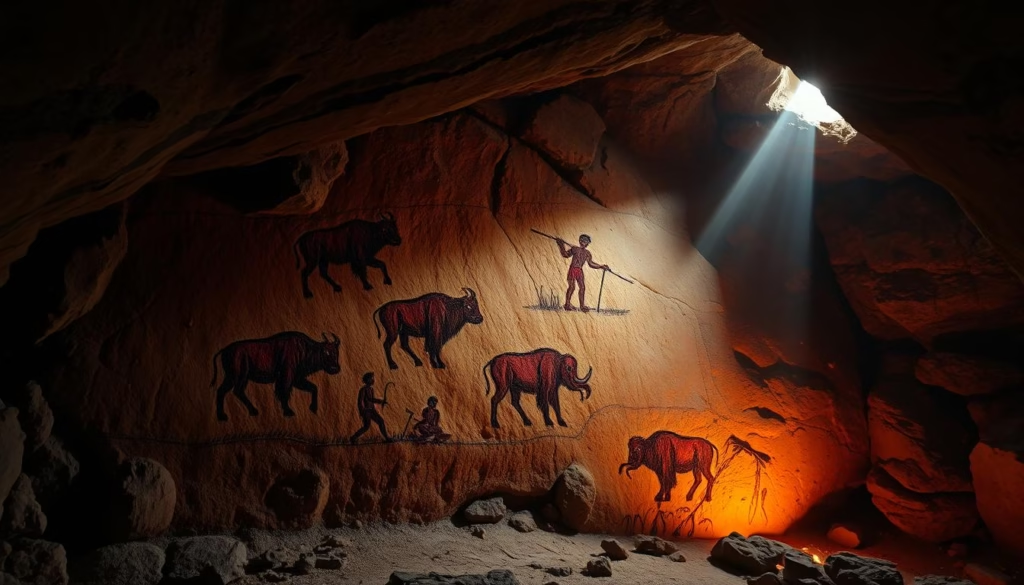Explore Prehistoric Cave Paintings: Origins and Impact
Step into a world where ancient stories come alive through vibrant colors and bold shapes. These early artworks, found on rocky walls worldwide, offer a rare glimpse into humanity’s creative roots. Researchers now believe some of the oldest pieces might predate modern humans, suggesting our evolutionary cousins also expressed complex ideas visually.
From Europe to Australia, these artistic treasures reveal shared human experiences across continents. They show animals, handprints, and symbolic patterns that transcend language and time. What makes them extraordinary isn’t just their age—some date back 64,000 years—but what they tell us about early minds. They prove abstract thinking and cultural traditions existed long before written history.
Why does this matter today? These images connect us to our ancestors’ fears, hopes, and daily lives. They challenge old assumptions about “primitive” societies, showing sophisticated techniques and deep spiritual meaning. As we decode their secrets, we’re rewriting the story of human innovation.
Key Takeaways
- Ancient wall art provides the earliest evidence of human creative expression
- Global discoveries span every continent except Antarctica
- Some artworks may have been created by other human species
- Reveals complex thinking patterns in early societies
- Offers insights into spiritual beliefs and daily life
- Challenges traditional timelines of cultural development
Introduction to Prehistoric Cave Paintings
Imagine standing in a silent underground chamber where ancient artists once mixed ochre and charcoal to leave lasting marks. These early creations go beyond basic sketches—they combine vivid imagery with intricate carvings and raised textures. Over 350 sites in France and Spain alone preserve these masterpieces, hidden for millennia in Earth’s natural vaults.

What makes these works special? They capture more than daily life—they reveal symbolic thinking. From charging bison to geometric patterns, each piece tells a story. Handprints pressed into stone feel like direct connections to people who lived 40,000 years ago. Unlike surface rock carvings, these protected spaces preserved details that would’ve vanished outdoors.
Global discoveries prove creativity thrived everywhere. Indonesia’s pig-deer paintings and Argentina’s stenciled hands show shared human impulses across continents. Even the materials tell a tale—artists used clay, ash, and minerals to create colors that still pop today.
Why did they make these? Some theories suggest spiritual rituals or hunting magic. Others think they were early teaching tools. Whatever their purpose, they remind us that artistic expression is as old as humanity itself—a universal language etched in stone.
Historical Context and Origins
Artistic expression began in darkness, where ancient hands shaped stories on stone. The earliest confirmed artwork—a red hand stencil in Spain’s Maltravieso cave—dates back over 64,000 years. What’s groundbreaking? This masterpiece predates modern humans in Europe, created instead by Neanderthals using primitive pigments.
Fast-forward 20,000 years, and we find another milestone in Indonesia. The Maros-Pangkep karst shelters the oldest known scene of people hunting pigs, painted 43,900 years ago. These discoveries rewrite history—proving symbolic thinking emerged earlier than we imagined.
Why did different human groups start creating art independently? Climate shifts and social complexity likely played roles. As ice ages altered landscapes, sheltered cave spaces became natural canvases for recording experiences and beliefs.
From Europe to Southeast Asia, early artists used similar techniques despite vast distances. Handprints appear worldwide, suggesting a universal human impulse to say: “I was here.” This shared creativity laid the foundation for every mural, sculpture, and digital design we make today.
Cave Art Across Millennia
Witness the transformation of ancient expressions from vivid realism to abstract forms. For over 60,000 years, artists returned to underground spaces, leaving layered marks that reveal shifting creative priorities. Lascaux and Altamira’s iconic animal figures, created 17,000 years ago, showcase peak naturalism—muscular bison and galloping horses seem ready to leap from stone.
As communities transitioned to farming around 10,000 BC, artistic styles simplified. Later works feature stick-like figures and geometric patterns rather than detailed wildlife. Archaeologists found 20+ generations of artwork in France’s Chauvet Cave alone—proof these spaces served as creative hubs for millennia.
| Period | Time Frame | Key Examples | Style Features |
|---|---|---|---|
| Upper Paleolithic | 40,000–12,000 BC | Chauvet, El Castillo | Dynamic animal forms |
| Magdalenian | 17,000–12,000 BC | Lascaux, Altamira | Shaded contours, perspective |
| Neolithic | 10,000–3,000 BC | Çatalhöyük, Tadrart Acacus | Symbolic shapes, human groups |
Climate shifts played a key role in these changes. When ice sheets retreated, paleolithic art traditions faded as people adapted to new landscapes. Yet the impulse to create endured—early Bronze Age societies still made handprints and spiral motifs in sheltered stone chambers.
This artistic journey reminds us that creativity evolves but never disappears. Each generation reimagined their world through available tools, proving art remains humanity’s timeless companion.
Techniques, Materials, and Methods
Uncover the secrets behind humanity’s first masterpieces. Early creators transformed raw earth into lasting expressions, using methods that still fascinate modern researchers. Their toolkit? Nature itself.
Natural Pigments and Tools
Artists crushed minerals to create vibrant pigments. Red and yellow came from iron-rich ochre, while charcoal provided deep blacks. Manganese oxide added brownish tones perfect for shading animal forms.
| Material | Source | Color Range | Use Examples |
|---|---|---|---|
| Ochre | Clay deposits | Yellow to red | Animal figures |
| Hematite | Iron minerals | Blood red | Handprints |
| Charcoal | Burnt wood | Jet black | Outline details |
Application Methods and Styles
Masters of improvisation, these creators used whatever worked. Fingers traced lines in soft surfaces. Hollow bones sprayed pigment for soft gradients. Some even chewed pigments to make liquid paint!
Three standout techniques shaped their work:
- Surface carving: Cutting outlines into stone before coloring
- Layered painting: Building depth with multiple pigment applications
- Relief sculpting: Molding clay directly on rock surfaces
Their greatest trick? Using bumpy walls to make animals look 3D. A bulging stone became a bison’s shoulder. A crack suggested a running deer’s leg. This clever approach makes ancient images leap off the wall—even after 40,000 years.
Dating and Chronology of Cave Paintings
Unlocking the age of ancient artwork requires more than guesswork—it demands cutting-edge science. Early attempts to date these creations faced hurdles, as materials like charcoal and ochre could absorb contaminants over millennia. This made initial estimates unreliable until new methods emerged.
Radiocarbon and Other Dating Methods
Radiocarbon dating revolutionized archaeology but stumbled with wall art. Why? Contamination from water seepage or later human visits skewed results. Scientists cracked the code by analyzing torch soot underneath pigment layers and plant fibers mixed into paints.
At France’s Chauvet Cave, 80+ radiocarbon tests revealed two creative bursts—36,000 and 29,000 years ago. This showed artists returned across generations, adding to existing works. Such precision helps map humanity’s artistic evolution through time.
Uranium-Thorium Dating Insights
This game-changing technique studies mineral crusts covering artwork. As water drips over paintings, it leaves carbonate deposits. By measuring uranium decay in these layers, researchers dated a Spanish hand stencil to over 64,000 years—older than modern humans in Europe.
Three key advantages make this method stand out:
- Works on inorganic materials radiocarbon can’t test
- Requires tiny samples to avoid damaging art
- Provides minimum age estimates for underlying pigments
These breakthroughs rewrite cultural timelines, proving our ancestors’ creative spark ignited much earlier than once believed. Each dated masterpiece adds another piece to humanity’s oldest story.
Themes and Motifs in Prehistoric Cave Paintings
Ancient walls whisper stories through bold animal shapes and mysterious handprints. These creations reveal what early humans valued most—survival, identity, and unseen forces. Three elements dominate: lifelike beasts, personal marks, and puzzling symbols.
Animal Figures and Hunting Scenes
Massive beasts steal the spotlight in most ancient art. Bison, deer, and wild horses appear with muscle definition and movement lines. Artists captured charging postures and herd dynamics, showing deep knowledge of animal behavior.
| Feature | Animal Figures | Hand Stencils |
|---|---|---|
| Common Subjects | Bison, horses, aurochs | Left hands (80% of cases) |
| Technique | Multi-colored shading | Pigment blowing |
| Global Locations | Europe, Indonesia | All inhabited continents |
| Theories | Hunting magic | Identity markers |
Hand Stencils and Abstract Symbols
Human presence appears through ghostly hand outlines. Artists pressed palms against stone, then sprayed pigment to create negative space. These prints cluster in groups, suggesting ritual activities or family records.
Curious symbols often flank the artwork—dots, zigzags, and ladder shapes. Some researchers think these represent early counting systems or star patterns. Their repetition across continents hints at shared symbolic thinking.
Why do human figures look stick-like compared to detailed animals? Maybe taboos against showing faces, or beliefs that animals held greater spiritual power. Either way, these motifs form humanity’s first visual language.
Regional Showcase of Paleolithic Art
Journey across continents to discover humanity’s first galleries etched in stone. From Europe’s deep caverns to Africa’s rocky outcrops, early artists left their mark using materials from their surroundings. These creations reveal how different cultures interpreted their world through paleolithic art.
European Masterpieces
France and Spain hold some of the most celebrated cave art sites. The Chauvet Cave features lifelike rhinos and lions painted 35,000 years ago. At El Castillo in Spain, red disks dating back 40,000 years adorn the walls—some of Europe’s oldest known works.
The Lascaux site stuns visitors with its 17,000-year-old bull figures. Artists used natural rock contours to create 3D effects. Altamira’s famous bison ceiling shows advanced shading techniques using charcoal and ochre.
Perspectives from Africa and Australia
Namibia’s Apollo 11 Cave houses animal drawings made 27,000 years ago. These works challenge old ideas about artistic development, proving creativity flourished worldwide. Australia’s rock art adds another layer—images of giant kangaroos and wombats extinct for 40,000 years.
Aboriginal artists used crushed minerals to create lasting images on sandstone. Like European sites, hand stencils appear here too. This global thread connects ancient cultures across vast distances through shared symbols.






